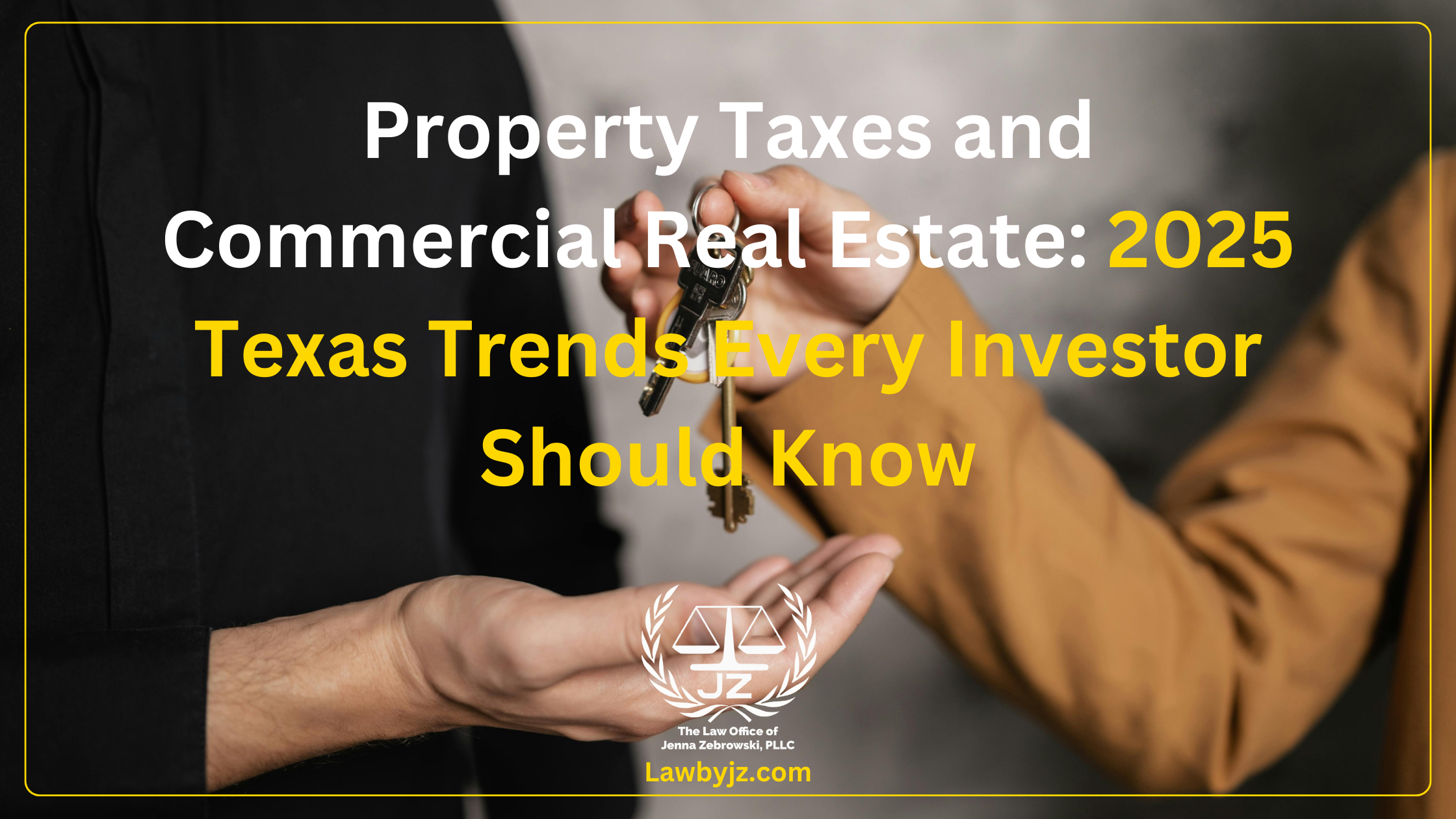
Property Taxes and Commercial Real Estate- 2025 Trends
Texas has historically been known for a lot of things, including being a business-friendly state. There’s no business income tax, and investors and consumers alike are looking to the Lone Star State to realize maximum value in the residential and commercial real estate market. There’s a lot of information, and speculation, available about the effect of rising property taxes on residential property owners and renters, but this article will discuss the effects of property taxes on commercial real estate for non-residential purposes. It will also discuss Texas Senate Bill 2 and strategies for controlling tax costs for landlords and tenants.
TEXAS SENATE BILL 2 (2025 PROPERTY TAX RELIEF ACT)
The influx of people and businesses into Texas means that the value of developed land is increasing sharply. More people are interested in the same amount of land, so that means the market is more competitive, and thus land is more expensive. After all, no one is making more real estate! More expensive land means more expensive land values. Increased property values means increased property taxes, and the owners in turn pass those increased costs on to the tenants occupying the land and the buildings on it. New investors are purchasing existing buildings and improving them (thus increasing their value), and developing land in desirable areas at an unprecedented rate. As a result, real estate taxes are skyrocketing, creating budget unpredictability, and pricing some tenants out of the market.
Texas Senate Bill 2 (2025 Property Tax Relief Act) is a pilot program which is being applied to non-homestead properties in Texas. That means this bill applies only to commercial properties (or properties owned by investors, even if they are for residential use, like multi-family or single family homes rented to tenants). The commercial property has to be valued at less than $5 million (taking inflation into account).
The stated purpose of the bill is to cap the appraisal value of these qualifying commercial properties. TXSB2 is designed to provide relief for commercial real estate investors, developers and property owners, by capping the appraisal values of these properties, and thus reducing the amount of annual tax increases. Limiting the increases to the annual value of the investment property should protect the commercial real estate asset from rapid tax escalation and hopefully provide some relief to the renters, who are ultimately the ones paying the increased price (or moving to a new property). This relief is slated to sunset at the end of 2026, so we’ll see what happens.
WHO BENEFITS
Owners of commercial real estate in high-growth areas will receive the maximum benefit of the limits on future tax increases, reducing the overall tax burden of the commercial property. Owners of developed commercial real estate assets in zones with higher appraisal values and high-growth zones are the real winners. These investors will reap the full benefit of the tax cap, since they already own the property, are not changing the use, and are not resetting the value of the asset.
Real estate tax increase protection will ease the spike in property valuations, and thus escalations, which will reduce the tax burden and create more predictability for the tenants and landlords. Landlords can pass these tax savings on to tenants in the form of predictable costs, making their commercial property more attractive to existing tenants renewing their leases and new tenants signing new leases. New tenants and those renegotiating their leases will have the best opportunity to reset base years for tax calculations and otherwise take advantage of the capped tax burden.
WHO DOES NOT BENEFIT
New investors and land developers are less likely to benefit from these real estate tax value caps on improved commercial property. The investors, and their tenants, will pay the cost of the tax increase due to the transfer in ownership. The tax caps aren’t retroactive, so a recently-acquired property will be subject to the full cost of the new tax valuation. Although the new tax burden is higher, these same investors should benefit from those caps on future increases in property values, and real estate taxes, at least through 2026.
Developers will likely see a bigger difference in tax costs once land is developed for commercial use. This additional cost could be a factor in slowing land investment and developments (along with the price increase on commercial construction materials due to tariffs and a host of other factors). Once the property is rezoned for commercial use, then the increased tax burden is applied. Land developers already see the gap between developed and undeveloped property tax costs, and it’s going to get bigger, as more land is developed for commercial use.
WHAT ABOUT NEW INVESTORS ?
New investors will have higher tax caps, due to the increased value (due to purchase price) of the property, so they will pass on the costs to their tenants. New investors won’t get the benefits of the tax caps, so retrofits to existing buildings and redevelopments might start to look more attractive.
TAKE ADVANTAGE OF CONTROLLED TAX COSTS
Savvy tenants in triple net (NNN) leases will look to take advantage of the predictability of capped tax increases under TXSB2. If a landlord receives a tax reduction (especially if the tenant contributed to the cost thereof), then the tenant should request to proportionally share in the reduction. Tenants will need to be more strategic about negotiations to cap their tax costs. It’s also important to review tax bills (and any other invoices!) that the tenant is required to pay under its lease. If there’s an audit right, it might be a good time to take advantage of that, to see what costs, including taxes, may need to be recalculated. Existing tenants, and those considering new leases in buildings with new owners, should negotiate protection from excessive tax increases into their leases.
For triple net (NNN) leases, controlled real estate tax increases should create more predictability in costs passed on to tenants. If these cost increases are controlled, then it’s easier for tenants and landlords alike to plan and make projections and formulate budgets. The predicted costs are easier to estimate accurately if the increase is already known.
It’s important for tenants to understand their tax obligations and to take advantage of any reduction possible. New investors and landlords need to be aware of tax consequences, and what they can, and cannot, expect the tenants to pay.
Go to lawbyjz.com and we can discuss your real estate property taxes.
#commercialrealestate #commercialrealestatelease #commercialleasenegotiations
